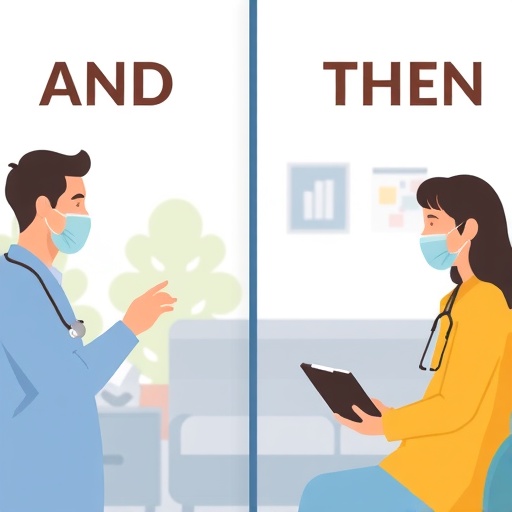In the rapidly evolving landscape of healthcare delivery, patient experience remains a critical pillar influencing outcomes, satisfaction, and institutional reputation. A groundbreaking study from the Perelman School of Medicine at the University of Pennsylvania illuminates an unexpected yet powerful resource for understanding patient sentiment: the simplicity of everyday language within online reviews. By applying advanced language analysis techniques to over a million Yelp reviews collected from nearly 139,000 healthcare facilities across the United States over seven years, researchers have uncovered nuanced patterns that differentiate positive patient experiences from negative ones, using nothing more than the frequency and context of commonplace words.
This innovative investigation centers on the intricate relationship between word usage in consumer-generated feedback and patient satisfaction metrics. Utilizing the Differential Language Analysis ToolKit (DLATK), a sophisticated computational platform designed for textual data mining and sentiment analysis, the team dissected reviews categorized as extremely negative (1- and 2-star) and exceedingly positive (4- and 5-star). The analytical framework allowed them to parse linguistic signals that convey underlying themes, elucidating how subtle differences in word choice can reflect broader systemic issues or highlight exemplary care within healthcare settings.
Among the most striking discoveries was the potent association of the negation term “not” with negative reviews. Its prevalence echoed the deep frustrations patients often experience, frequently entwined with themes of miscommunication and administrative hurdles. Terms like “told,” “said,” “call,” and “asked” emerged as linguistic markers of communication failures or dissatisfaction, underscoring that the quality of interaction—both verbal and procedural—is frequently at the heart of patients’ grievances. This finding aligns with prior research which identified “told” as a dominant term in patient complaints, reinforcing the narrative that ineffective communication profoundly impacts patient perceptions.
.adsslot_IGzY0Fyx4S{ width:728px !important; height:90px !important; }
@media (max-width:1199px) { .adsslot_IGzY0Fyx4S{ width:468px !important; height:60px !important; } }
@media (max-width:767px) { .adsslot_IGzY0Fyx4S{ width:320px !important; height:50px !important; } }
ADVERTISEMENT
Diving deeper into the negative sentiment cluster, common subjects included problematic phone interactions, exemplified by long hold times and unreturned calls, as well as disputes over billing and perceived inadequate treatment. Interestingly, while expectations posited poor clinical care would dominate negative sentiments, it was the administrative and communication shortcomings that took precedence. This nuance reveals that structural inefficiencies within health systems, rather than direct clinical incompetence, are chief contributors to patient dissatisfaction—a factor often overlooked in traditional patient experience surveys.
Conversely, positive reviews revealed a starkly different linguistic landscape. The coordinating conjunction “and” stood out prominently, serving as a linguistic signal that patients were often recounting comprehensive, interconnected positive experiences. The word “great” closely followed, reaffirming the overall satisfaction present in these narratives. More importantly, terms capturing kindness and empathy—such as “friendly,” “helpful,” and “kind”—were frequently used, painting a picture of healthcare as a human-centered encounter where emotional support is as valued as clinical expertise.
The methodological rigor of this study, leveraging large-scale, real-world data, offers a fresh paradigm for healthcare quality assessment. Traditional patient experience tools often suffer from lag times and limited reach, capturing snapshots without real-time adaptivity. The researchers advocate for integrating these linguistic analytics derived from online reviews into dynamic dashboards accessible to health administrators and frontline providers. This innovation holds promise for near-instant feedback loops, enabling facilities to identify and rectify emergent issues expeditiously, thereby elevating the standard of care in a continuous, data-driven manner.
The timing of this research is particularly pertinent given the documented downturn in health care reviews following the COVID-19 pandemic, a period marked by unprecedented strain on health systems and patient uncertainty. While online sentiments have yet to recuperate fully, the linguistic patterns unearthed could guide targeted interventions to rebuild trust and improve communication channels, essential steps in post-pandemic recovery of patient confidence.
Moreover, the study points to systemic rather than anecdotal causes underlying negative patient reviews. This distinction is crucial as it suggests that interventions must transcend isolated fixes and address foundational organizational culture and infrastructure. By correlating linguistic data with facility characteristics such as size, ownership models, and patient volumes, future investigations could identify actionable determinants for systemic improvement, tailoring strategies to diverse healthcare environments.
Equally significant is the research team’s intent to spotlight high-performing institutions consistently earning favorable reviews. Identifying and understanding the practices and environments that enable these “stars” to succeed—despite the challenges faced across the healthcare spectrum—represents an invaluable roadmap. Learning from these exemplars could catalyze sector-wide enhancements by disseminating best practices regarding communication protocols, staff engagement, and patient support mechanisms.
In essence, this study validates the profound intelligence embedded within the seemingly mundane elements of language and spotlights the power of digital patient narratives as a wellspring for quality improvement. It posits that even simple connecting words, ordinarily overlooked, carry hidden signals about the emotional and operational texture of patient experiences. Harnessing this knowledge in real time transforms the vast, untapped domain of online reviews into a potent, scalable tool for reshaping the future of health care delivery in the United States and beyond.
Continuing to refine the intersection of computational linguistics and healthcare service evaluation promises not only to amplify patient voices but also to shorten the feedback loop between experience and action. As the health sector grapples with increasing demand, resource limitations, and evolving patient expectations, integrating linguistic analytics into everyday clinical governance could emerge as a pivotal lever to drive more agile, responsive, and patient-centered health systems worldwide.
Subject of Research: People
Article Title: Online Reviews of Health Care Facilities
Web References:
https://jamanetwork.com/journals/jamanetworkopen/fullarticle/10.1001/jamanetworkopen.2025.24505?utm_source=For_The_Media&utm_medium=referral&utm_campaign=ftm_links&utm_term=080125
References:
DOI: 10.1001/jamanetworkopen.2025.24505
Keywords: Internet, Health care delivery
Tags: advanced language analysis in medicinecomputational linguistics in healthcareconsumer-generated feedback analysisdifferential language analysis toolkithealthcare facility reputation managementhospital visit experienceslanguage patterns in healthcare feedbackonline reviews sentiment analysispatient experience improvement strategiespatient satisfaction analysispositive vs negative patient experiencesword usage in patient reviews





